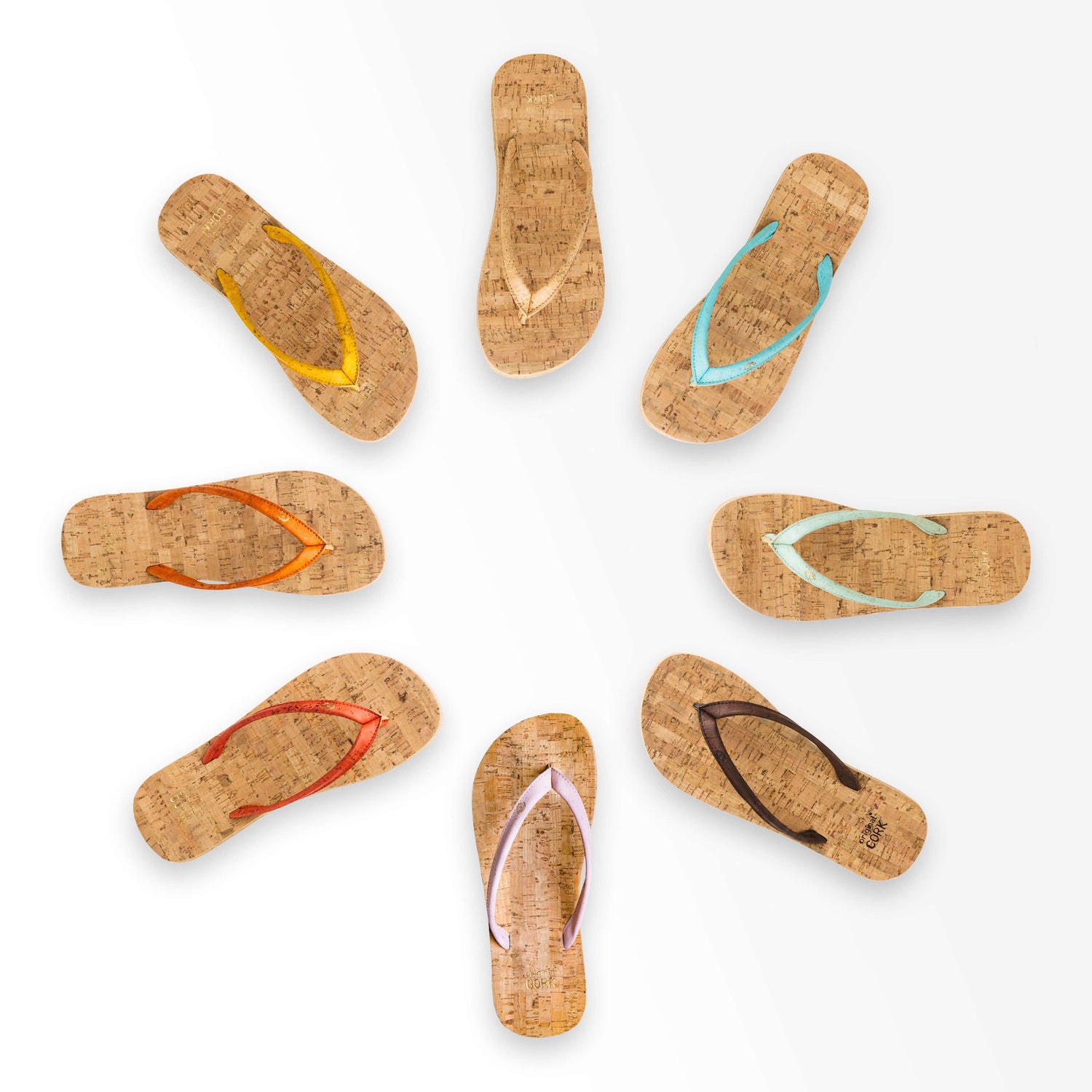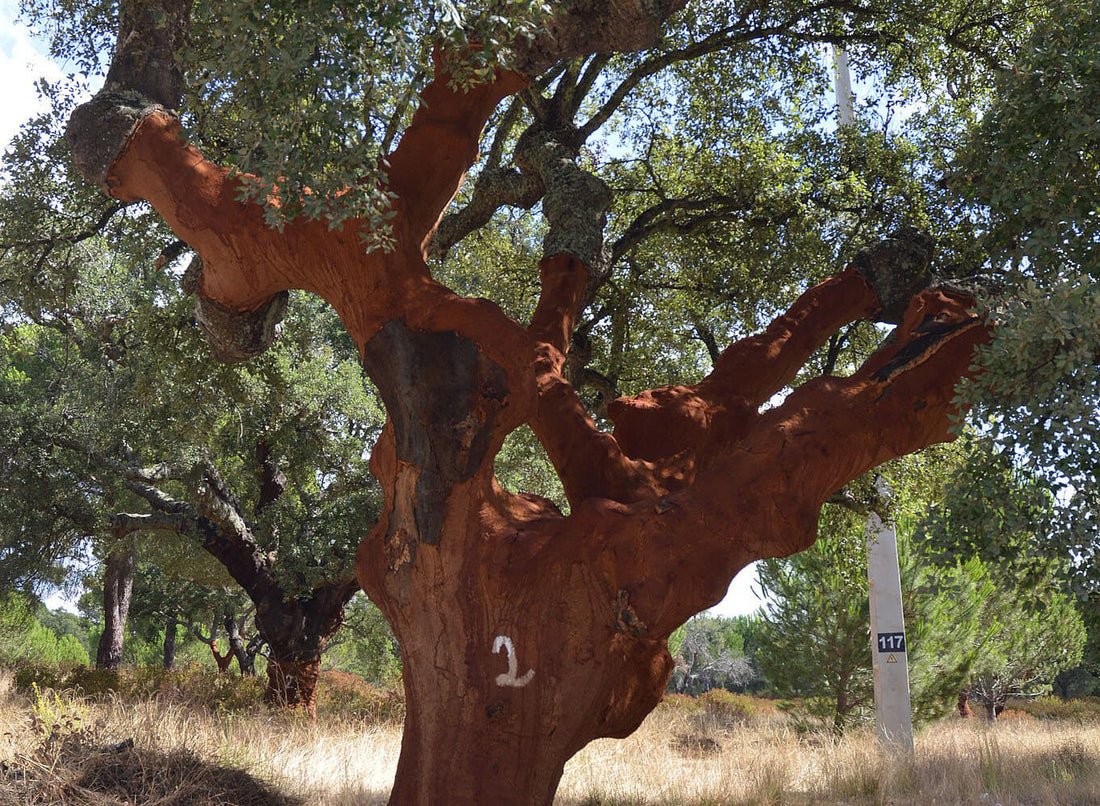By now, 6 years after launching our store, we have written a lot about cork. But, most of what has been said by us and other cork connoisseurs out there usually hits on the same major points about cork - its unique characteristics and qualities, its contribution to biodiversity in the forests where the cork oak grows, and why it's great for many different applications. So we set out to find some interesting and little-known facts about cork that aren't always mentioned in the discussion. Some of them might surprise you!
1 Cork harvesters are among the highest paid agricultural workers in the world
The multi-generational families of skilled workers who harvest the cork oak by hand are some of the highest paid agricultural workers in the world, earning between 80 euros to 120 euros per day, plus insurance that provides wage replacement and medical benefits for the rare few who might get injured during the harvest. This is due to the high level of expertise necessary to harvest the cork without damaging this precious resource. The skill of hand-stripping the bark, which is passed down from parents to children, is necessary to prevent damage to the tree.
The workers are paid not on the amount of weight they harvest, but instead are paid based on a fixed daily wage, in order to assure that they perform their harvesting work slowly and with maximum attention to the health of the trees.
Cork harvesting is delicate work done entirely without machinery. The cork harvesters work in pairs, one person who climbs up the tree and one who stays on the ground. Together they begin to remove the dead layer of bark with their hand-axes, judging the bark's thickness by the sound resonating from the steel axe, and carve out rectangular cork planks. They know from experience just how much force to use when striking the tree with the axe to not cut too deeply. They make two types of cuts on the tree - one horizontal cut around the plant and several vertical cuts called rulers or openings. To free the cork from the tree, the extractor pushes the handle of the axe into the vertical openings.

Worker stripping the cork oak of its bark. -- Credit: Amorim.com
2 Cork is used in train, airplane, and bus transportation systems
Cork is being developed as a solution to replacing leather and synthetic materials in cars, busses, trains, and planes. In Portugal, Corticeira Amorim is working on many of these developments. LIFE is a project designing an innovative design concept for airplane interiors, integrating sustainable materials such as cork. Cork is incorporated into the airplane’s ceiling, lateral panels and seating in conjunction with advanced composite materials, including carbon fiber, which results in a significant overall reduction in weight, coupled with effective gains in terms of the thermal, acoustic and anti-vibration properties.
Another project is IBUS, which is working to develop cork based components for bus interiors. ECOTRAIN, as you might guess, is a project fitting cork into high-speed trains enabling a reduction in weight and thereby optimizing energy consumption levels. ISEAT is integrating cork into seats for trains and underground coaches, and PLASCORK is working to replace synthetic components with cork in car interiors.

Interior train and bus components in cork. -- Credit: Amorim.com
3 The cork oak is the only tree protected by law in Portugal
The cork oak is the only tree formally protected by law in Portugal. This is largely due to its importance to the country's economy, as a third of all global cork production comes from this region.
The Portuguese government has recognized and legally protected the cork oak for its vital role in providing income and maintaining jobs for thousands of rural communities. As such, there are numerous regulations in place that prohibit deforestation of these trees and limit usage only to activities that maintain or improve their health and longevity.
Furthermore, specific areas throughout Portugal have been marked as Natural Parks and Reserves to help ensure the survival and conservation of these trees. These measures help ensure that high-quality cork bark can continue to be produced in large quantities while also protecting natural habitats and providing sustainable sources of income for those living off the land.
This extraordinary law was created in the 1970s in response to Portuguese cork producers outrage after 500,000 acres of cork had been replaced with eucalyptus for the pulp industry.
The law states that without permission from the government, it’s illegal to cut down any cork oak in Portugal, dead or alive. A landowner caught clearing a montado pays a steep fine and is barred from using the land for 25 years. This is why standing dead oaks are not an uncommon sight in montados.

View from above of a cork forest in Portugal. -- Credit: Amorim.com
4 Cork oaks can grow with viable cork bark only in the Mediterranean region
Cork oaks can only grow viable cork bark suitable for the cork industry in the Mediterranean region. This is because there are a number of climatic and geographic conditions required for healthy cork oak trees to be able to produce good quality cork bark. These conditions include high temperatures, plenty of rainfall throughout the year, particular soil types, and an undisturbed habitat.
Cork oaks are primarily found in Portugal, Spain and parts of North Africa that fit these criteria. In addition to meeting specific environmental requirements, cork oak forests also provide numerous benefits to the ecosystems in which they are grown. They help improve air quality by trapping dust particles and carbon dioxide, as well as providing a home for a range of wildlife species such as birds and lizards.
Although it is possible to grow cork oaks outside of this region, their bark may not necessarily be suitable for use in the processing and production of traditional cork products such as wine stoppers or insulation material. Therefore, many countries look towards importing their raw materials from Portugal or Spain rather than trying to cultivate them domestically.
In the seven cork-producing countries of the Mediterranean, more than 100,000 people directly or indirectly depend on this sector, according to the WWF. In Portugal, the cork oak and forest systems represent 8.310 direct manufacturing jobs.

5 Cork oak trees store more carbon than other trees in order to regenerate their bark
As you probably know by now, cork is actually the bark of the cork oak tree and can be regenerated, making it a particularly sustainable and renewable resource. In fact, cork oaks are the only tree that regenerates with the removal of its bark. A harvested cork oak tree can absorb up to 5 times more carbon dioxide than than other trees of a similar size. After the cork bark is harvested, the tree quickly forms new layers of cork to restore its protective barrier. This sends it into "overdrive," storing more CO2 and producing more oxygen than it would otherwise.

Cork bark removed from the trees. -- Credit: Montedavida.com
6 The number painted on a peeled cork oak refers to the year it was harvested
After the harvest, the tree itself is carefully marked with a number, which is painted on using a white paint. This is done to keep track of the year when its most recent harvest took place, so others will know when it can be harvested again. Each particular tree needs nine to twelve years from the year of its last harvest before it is ready for the next removal of its bark. The numbers are written largely enough to be easy to read from a distance. You may see just one number painted on the tree, for example "9", which refers to the last number in the year, such as "2009".

Cork tree in Portugal with a white number painted on it. -- Credit: Donald Scott Lee
7 The cork oak forests of Portugal are Europe's Amazon forest
Cork oak landscapes are one of the best examples of balanced conservation and development anywhere in the world.
The cork oak forests make up an ecosystem of unparalleled biological richness. The cork oak trees preserve the region's thin soils and scarce groundwater. The trees help conserve soil by protecting against wind erosion and increasing the rate at which rainwater is absorbed. Without them, the area will quickly become a desert and uninhabitable for humans. It would also spell the end for the Iberian Lynx, which lives in many of Spain and Portugal's cork forests, and which has been declared the world's most endangered wild cat. Plant diversity can reach 135 species every square meter, and many have aromatic, culinary, or medicinal value. Cork oak forests also host a rich diversity of fauna, including spiders, spadefoot toads, geckos, skinks, vipers, mongoose, wild cats, roe deer, boars, Barbary deer, and genets.
A decline in demand for cork would be calamitous for the region's arid areas as well as spell disaster for rare wildlife. The cork oak forest is the basis of one of the 35 most important ecosystems in the world for preserving biodiversity, on par with the Amazon rainforest, the African Savanna and Borneo. "The cork oak forests of Portugal are Europe's Amazon forests - they support the greatest bio-diversity anywhere in Europe," said Jorge Paiva, a botanist at Coimbra University.

Lynx peeking out from behind a cork oak. -- Credit: Unknown
8 Only the third and subsequent harvests produce cork with an even structure good enough to be used for wine corks.
The Portuguese call this cork that can be used for wine stoppers "amadia." The bark of the cork oak is stripped away every nine to ten years and it takes at least 25 years for a new tree to be ready to be harvested for the first time. But, the first and second harvests will produce cork that’s not uniform enough to be used as bottle stoppers.
The first stripping produces cork (virgin cork - "desbóia") that is too hard to be easily handled because it has an irregular structure. It is used in products like flooring and insulation, or ground up and used in granulated cork products like bulletin boards and coasters. 9 to 12 years later a second harvest produces better material, but still not at a high enough quality for wine stoppers. Cork used to make accessories for fashion usually come from these first two harvests as well, although some cork products are made from recycled cork from wine corks that have been given a second life.

9 The ancient Greeks revered cork oak trees as a symbol of liberty and honor
In the 1st century CE, the Roman naturalist Pliny the Elder made frequent references to cork oaks in his writings in Natural History. He explained that in Greece the trees were adored as symbols of liberty and honor, and for this reason only priests were allowed to cut them down. He also wrote that cork oaks were consecrated to the god of Olympus, Jupiter, and the leaves and branches of the cork oak were used to crown victorious athletes.

Cork oaks in ancient forest. -- Credit: Bonny Bonafilla
10 The discovery of cells is thanks to cork
Cells were discovered in 1665 by Robert Hooke. On observing a sliver of cork under a rudimentary microscope, the English scientist discovered that it was made up of multifaceted cavities, which he called cells (from the Latin cellula, small room).
In a world before microscopes, people had no way to look inside their own bodies or the bodies of other creatures to answer questions about life. But the discovery of cells by Robert Hooke in 1665 changed all that. Hooke was the first to observe the structure of cells, and living cells at that, and this contributed greatly to our understanding of biology and the life sciences. But how did he do it? The answer lies in cork. Cork is a light, spongy material, made from the outer layer of bark from cork oak trees. It is known for its unique ability to be impermeable to liquids, making it an ideal material for sealing bottles, jars, and many other containers. Hooke was able to use this property to his advantage. To observe cells, he collected pieces of cork and sliced them very thin, so thin in fact that he was able to see the individual cells within the cork. He then used a microscope to magnify the cork and observed the cells’ structure and shape. He was the first to do this, and his observations allowed him to identify and name the individual cell walls as “cellulae.”
Hooke's discovery of cells laid the foundation for our current understanding of biology, and the contribution of cork to this discovery was significant. Cork allowed Hooke to make thin enough slices so that he could observe the individual cells. By observing these cells in cork, Hooke was able to provide a crucial definition of the structure and function of cells. Today, cork still plays an important role in research and education in the life sciences, providing a unique material for scientists to observe and study. We often take for granted the fact that cork was a crucial step in the discovery of cells, but without it, Hooke would not have been able to make his observations. Cork truly contributed to a turning point in science, one that continues to shape our understanding of life even today.

Did you learn something you didn't know about cork? Let us know!



1 comment
Wonderful Information .